
The McDonald's Sign, also known as McDonald's Store #433 Sign, in Pine Bluff, Arkansas, United States, is one of only two surviving examples of a single-arch McDonald's sign. The sign was erected in 1962 and remained at its original location until 2007. That year, McDonald's Store #433 moved and the sign was renovated and moved to the new location. The McDonald's sign was added to the U.S. National Register of Historic Places in 2006.

The Community Theatre is a historic theatre building at 207 West 2nd Avenue in Pine Bluff, Arkansas. It is a two-story brick building, finished in stucco, with Moderne styling. It was built in 1889, and housed first a furniture store, and then a five and dime, before being converted for theatrical use in the 1920s. Its present Moderne styling dates to renovations made in the wake of a 1951 fire.

Union Station is a former railroad station at East 4th Ave. and State St. in Pine Bluff, Jefferson County, Arkansas. The station was originally at the union of the Cotton Belt and Iron Mountain railroads, and now houses the Pine Bluff/Jefferson County Historical Society museum. It is a single-story brick building, with a hip roof whose long eaves are supported by iron columns and half-truss brackets. The station was built in 1906 by the Iron Mountain Railroad. It had been a stop on the St. Louis Southwestern's Lone Star (Memphis-Dallas), and also on the railway's St. Louis-Dallas trains.
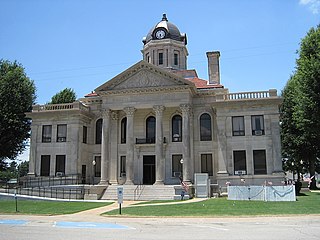
The Poinsett County Courthouse is located on a city block of downtown Harrisburg, Arkansas, bounded by Court, North Main, Market, and East Streets. It is a two-story granite and concrete structure, set on a raised foundation. The central block is topped by a tiled hip roof, with an octagonal tower set on a square base at its center. The front facade has a Classical Revival tetrastyle Corinthian portico with a fully enclosed gable pediment. Wings on either side of the main block are lower in height, but project beyond the main block's front and back. They are capped by low balustrade surrounding a flat roof. The courthouse was designed by Mitchell Seligman of Pine Bluff. Construction began in 1918 and it was completed in 1920. This courthouse was built to replace an earlier courthouse which had been destroyed by fire on May 4, 1917.

The Jefferson County Courthouse is the center of county government for Jefferson County, Arkansas. It is located in the Pine Bluff Commercial Historic District in Pine Bluff on the border between the Arkansas delta and Piney Woods.
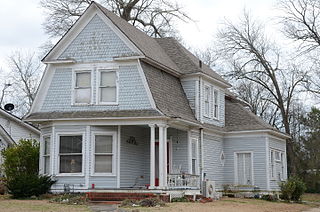
The Gatewood House is a historic house at 235 Pine Bluff Street in Malvern, Arkansas. It is a two-story wood-frame structure, roughly rectangular in plan, with a gambrel roof and weatherboard exterior. The gambrel roof is unusual in that the upper level slightly overhangs the steeper lower parts. The front-facing gable rests above a polygonal bay window on the left and a recessed porch on the right, which is supported by clustered Tuscan columns. Built in 1905, the building represents a well-executed example of a vernacular interpretation of the Shingle style of architecture.

The Pine Bluff Street Historic District encompasses a well-preserved residential area of Malvern, Arkansas, that was developed between about 1890 and 1940. It extends along Pine Bluff Street, just east of the city center, between Gloster Court and McNeal Street. Most of the houses in this area are American Craftsman style bungalows, although the district is also home to one of Arkansas' finest Second Empire houses, the Bratt-Lea House at 225 Pine Bluff Street. The district was listed on the National Register of Historic Places in 1999, and includes two previously-listed properties: the Gatewood House, and the Alderson-Coston House.
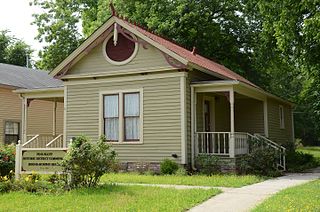
The Boone–Murphy House is a historic house located in Pine Bluff, Arkansas.

The Floyd B. Brown House is a historic house at 1401 South Georgia Street in Pine Bluff, Arkansas. It is a single-story vernacular brick structure, with a gable roof and brick foundation. Decorative elements on the building are minimal, with scalloped trim elements at the gables and eaves, and a fanlight in the front-facing gable. The house was built in 1954 for Floyd and Lillian Brown. The Browns were prominent African-American educators: Floyd Brown founded the Fargo Training School in Fargo, Arkansas, and his wife Lillian taught there.

Du Bocage is a historic house at 1115 West 4th Street in Pine Bluff, Arkansas. It is a two-story wood-frame structure, with a side gable roof and weatherboard siding. A two-story gabled section projects from the center of the front, supported by large Greek Revival columns, with a balustraded porch on the second level. The house was built in 1866 by Joseph Bocage, a veteran of the American Civil War, using lumber from the land and milled by his own mills. Bocage was a prominent local businessman, who owned a brick manufactory and a steam engine production plant in the city.
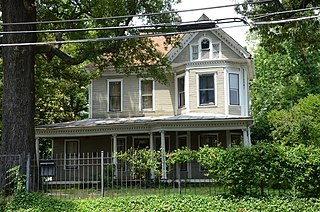
The Gibson-Burnham House is a historic house at 1326 Cherry Street in Pine Bluff, Arkansas. It is a roughly L-shaped two story wood-frame structure, with a hip roof across its front and a gabled rear section. A single-story porch extends across the front, supported by Ionic columns. Its interior has well-preserved original woodwork, including notable a staircase built out of quarter-sawn oak and displayed at the 1904 St. Louis World's Fair. Built in 1904 by a local plantation owner, it is a fine local example of Colonial Revival architecture.

The Howson House is a historic house at 1700 South Olive Street in Pine Bluff, Arkansas. It is a 2+1⁄2-story structure, faced in brick on the first floor and half-timbered stucco on the second. A single-story porch extends across the main facade, supported by square brick piers, with exposed rafter ends in the shed roof. The house was designed by the noted Arkansas firm of Thompson & Harding, and was built in 1918.

The Hudson-Grace-Borreson House is a historic house at 719 West Barraque Street in Pine Bluff, Arkansas. With an evolutionary construction history dating to about 1830, it is a unique and distinctive blend of Greek Revival, Second Empire, and New Orleans French architectural styles. It is a 1+1⁄2-story wood-frame structure, finished in bevel siding, with a dormered mansard roof that has an original iron railing at the boundary between the roof slopes. It has a porch extending across the front, featuring hexagonal posts and delicate turned woodwork. The house began as a two-room cabin about 1830, and was enlarged and altered in 1860. Its most prominent owner, William Grace, was a local lawyer, politician, and veteran of the American Civil War.
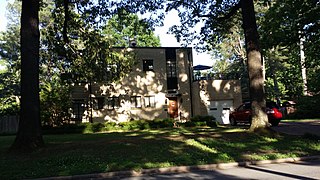
The Jewel Bain House Number 2 is a historic house at 3601 South Cherry Street in Pine Bluff, Arkansas. It is a roughly cubic brick structure, two stories in height, covered by a hip roof. The brick walls are accented with carrara glass. A carport extends from the main block to the south, and a single-story ell extends south. Built in 1937, the house was the second of four houses designed by Jewel Bain for her family. It is rare within the state as an excellent example of a residential application of the Moderne style of architecture.

The MacMillan-Dilley House is a historic house at 407 Martin Avenue in Pine Bluff, Arkansas. It is a two-story wood-frame structure, with a cross-gable roof configuration, and distinctive siding consisting of boards topped by moulding. The underside of the extended roof gables are painted white, and the building has other features that are signatures of the Prairie School of design. It was built in 1903 to a design by Chicago architect Hugh M.G. Garden, who had supposedly studied with the major exponent of the Prairie School style, Frank Lloyd Wright.
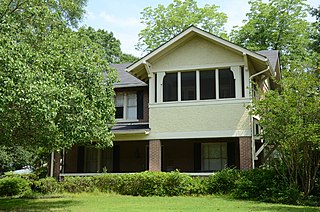
The Nichol House is a historic house at 205 Park Place in Pine Bluff, Arkansas. It is a two-story wood-frame structure, its exterior finished in a combination of brick veneer and stucco. A single-story shed-roofed porch extends across the front, supported by brick piers, with a second-story enclosed porch above the right side. Gable ends feature large Craftsman brackets and exposed rafter ends. The house was designed by Charles L. Thompson and was built in 1916 for a local banker.

The Dr. John Walter Parker Sr. House is a historic house at 1405 South Alabama Street in Pine Bluff, Arkansas. It is a single-story brick building, with a complex gabled roof line and a porch that curves from the front around to the left side. Built in 1909–10, it is believed to be one of the first brick houses in the community to be built for, and owned by, an African American. John Walker Parker, for whom it was built, was a dentist who opened his practice in Pine Bluff in 1905.

The Prigmore House is a historic house at 1104 West Fifth Avenue in Pine Bluff, Arkansas. It is a two-story wood-frame structure, with a gable roof, weatherboard siding, and a high brick foundation. A single-story gabled ell extends to the rear. A single-story porch extends across the front facade, supported by grouped columns. The house was built about 1873 by George Prigmore, a veteran of the American Civil War, and is a rare surviving property in Pine Bluff from that period.

The Trulock-Cook House is a historic house at 703 West 2nd Avenue in Pine Bluff, Arkansas. It is a 1+1⁄2-story wood-frame structure, built about 1903 in an unusual combination of Shingle and Colonial Revival styles. It has a two-stage gambrel roof, which slopes down in one section to form the roof of a single-story porch that wraps around the porch on the southwest corner. The porch also wraps around a semicircular bay that rises above the main entrance, and is supported by Tuscan columns. The house is one of Pine Bluff's few surviving Shingle style buildings.



















